Send us your stories, memories and photographs of the Nobel Peace prize winner and former South African president.
(CNN) -- He was loved and admired the world over, profiled in books and movies, and showered with awards and accolades. But even the most public of personalities have little-known facts buried in their biographies.
Here are 10 surprising facts you probably didn't know about Nelson Mandela:
1. He lived up to his name: Mandela's birth name was Rolihlahla. In his Xhosa tribe, the name means pulling the branch of a tree or troublemaker. (The name "Nelson" was given to him by his teacher on his first day of elementary school. It's not clear why she chose that particular name. It was the 1920s, and African children were given English names so colonial masters could pronounce them easily).
2. He had a cameo in a Spike Lee film: He had a bit part in Spike Lee's 1992 biopic "Malcolm X." At the very end of the movie, he plays a teacher reciting Malcolm X's famous speech to a room full of Soweto school kids. But the pacifist Mandela wouldn't say "by any means necessary." So Lee cut back to footage of Malcolm X to close out the film.
.cnnArticleGalleryNav{border:1px solid #000;cursor:pointer;float:left;height:25px;text-align:center;width:25px} .cnnArticleGalleryNavOn{background-color:#C03;border:1px solid #000;float:left;height:25px;text-align:center;width:20px} .cnnArticleGalleryNavDisabled{background-color:#222;border:1px solid #000;color:#666;float:left;height:25px;text-align:center;width:25px} .cnnArticleExpandableTarget{background-color:#000;display:none;position:absolute} .cnnArticlePhotoContainer{height:122px;width:214px} .cnnArticleBoxImage{cursor:pointer;height:122px;padding-top:0;width:214px} .cnnArticleGalleryCaptionControl{background-color:#000;color:#FFF} .cnnArticleGalleryCaptionControlText{cursor:pointer;float:right;font-size:10px;padding:3px 10px 3px 3px} .cnnArticleGalleryPhotoContainer cite{background:none repeat scroll 0 0 #000;bottom:48px;color:#FFF;height:auto;left:420px;opacity:.7;position:absolute;width:200px;padding:10px} .cnnArticleGalleryClose{background-color:#fff;display:block;text-align:right} .cnnArticleGalleryCloseButton{cursor:pointer} .cnnArticleGalleryNavPrevNext span{background-color:#444;color:#CCC;cursor:pointer;float:left;height:23px;text-align:center;width:26px;padding:4px 0 0} .cnnArticleGalleryNavPrevNextDisabled span{background-color:#444;color:#666;float:left;height:23px;text-align:center;width:25px;padding:4px 0 0} .cnnVerticalGalleryPhoto{padding-right:68px;width:270px;margin:0 auto} .cnnGalleryContainer{float:left;clear:left;margin:0 0 20px;padding:0 0 0 10px} Nelson Mandela, the prisoner-turned-president who reconciled South Africa after the end of apartheid, died on Thursday, December 5, according to the country's president, Jacob Zuma. Mandela was 95. Mandela became president of the African National Congress Youth League in 1951. Mandela poses for a photo, circa 1950. Mandela poses in boxing gloves in 1952. Mandela in the office of Mandela & Tambo, a law practice set up in Johannesburg by Mandela and Oliver Tambo to provide free or affordable legal representation to black South Africans. From left: Patrick Molaoa, Robert Resha and Mandela walk to the courtroom for their treason trial in Johannesburg. Mandela married his second wife, social worker Winnie Madikizela, in 1958. At the time, he was an active member of the African National Congress and had begun his lifelong commitment to ending segregation in South Africa. Nelson and Winnie Mandela raise their fists to salute a cheering crowd upon his 1990 release from Victor Verster Prison. He was still as upright and proud, he would say, as the day he walked into prison 27 years before. A jubilant South African holds up a newspaper announcing Mandela's release from prison at an ANC rally in Soweto on February 11, 1990. Two days later, more than 100,000 people attended a rally celebrating his release from jail. Mandela and Zambian President Kenneth Kaunda arrive at an ANC rally on March 3, 1990, in Lusaka, Zambia. Mandela was elected president of the ANC the next year. After his release in 1990, Mandela embarked on a world tour, meeting U.S. President George H.W. Bush at the White House in June. At his Soweto home on July 18, 1990, Mandela blows out the candles on his 72nd birthday cake. It was the first birthday he celebrated as a free man since the 1960s. Mandela and his wife react to supporters during a visit to Brazil at the governor's palace in Rio De Janeiro, on August 1, 1991. South African President Frederik de Klerk, right, and Mandela shared a Nobel Peace Prize in 1993 for their work to secure a peaceful transition from apartheid rule. Mandela votes for the first time in his life on March 26, 1994. On April 27, 1994, a long line of people snake toward a polling station in the black township of Soweto outside of Johannesburg in the nation's first all-race elections. Mandela in Mmabatho for an election rally on March 15, 1994. Mandela was elected president in the first open election in South African history on April 29, 1994. He's pictured here taking the oath at his inauguration in May, becoming the nation's first black president. Mandela, left, cheers as Springbok Rugby captain Francois Pienaar holds the Webb Ellis trophy high after winning the World Cup Rugby Championship in Johannesburg on June 24, 1995. After one term as president, Mandela stepped down. Thabo Mvuyelwa Mbeki, at right, was sworn in as his replacement in June 1999. Mandela sits outside his former prison cell on Robben Island on November 28, 2003, ahead of his AIDS benefit concert at Green Point Stadium in Cape Town. He was sent to the infamous prison five miles off the coast of South Africa, where he spent 18 of his 27 years behind bars. Mandela shows something to a group of international journalists visiting the Nelson Mandela Foundation in Johannesburg in May 2004. Mandela sits with his wife, Graca Machel, and his grandchildren at his son's funeral on January 15, 2005. He disclosed that his son, Makgatho Lewanika Mandela, had died of AIDS and said the disease should be given publicity so people would stop viewing it as extraordinary. The "46664 Arctic" benefit concert was held in Tromso, Norway, on June 11, 2005. 46664 was Mandela's identification number in prison. Here, artists who performed at the event surround him. Mandela attends an HIV/AIDs concert in Johannesburg on February 17, 2005. Former U.S. President Bill Clinton leans down to whisper to former South African President Nelson Mandela during a visit to the Nelson Mandela Foundation on July 19, 2007, in Johannesburg. A bronze statue of Mandela was unveiled in Parliament Square in London on August 29, 2007. The 9-foot statue faces the Houses of Parliament. Mandela leaves the InterContinental Hotel after a photoshoot with celebrity photographer Terry O'Neil on June 26, 2008, in London. Mandela meets in 2009 with international children as part of his 46664 Foundation. Nelson Mandela and his third wife, Graca Machel, arrive at the 2010 World Cup before the final match between Netherlands and Spain on July 11, 2010, at Soccer City Stadium in Soweto. Then-U.S. Secretary of State Hillary Clinton meets with Mandela at his home in Qunu, South Africa, on August 6, 2012. The evolution of Nelson Mandela The evolution of Nelson Mandela The evolution of Nelson Mandela The evolution of Nelson Mandela The evolution of Nelson Mandela The evolution of Nelson Mandela The evolution of Nelson Mandela The evolution of Nelson Mandela The evolution of Nelson Mandela The evolution of Nelson Mandela The evolution of Nelson Mandela The evolution of Nelson Mandela The evolution of Nelson Mandela The evolution of Nelson Mandela The evolution of Nelson Mandela The evolution of Nelson Mandela The evolution of Nelson Mandela The evolution of Nelson Mandela The evolution of Nelson Mandela The evolution of Nelson Mandela The evolution of Nelson Mandela The evolution of Nelson Mandela The evolution of Nelson Mandela The evolution of Nelson Mandela The evolution of Nelson Mandela The evolution of Nelson Mandela The evolution of Nelson Mandela The evolution of Nelson Mandela The evolution of Nelson Mandela The evolution of Nelson Mandela The evolution of Nelson Mandela HIDE CAPTION << <
Nelson Mandela, the prisoner-turned-president who reconciled South Africa after the end of apartheid, died on Thursday, December 5, according to the country's president, Jacob Zuma. Mandela was 95. Mandela became president of the African National Congress Youth League in 1951. Mandela poses for a photo, circa 1950. Mandela poses in boxing gloves in 1952. Mandela in the office of Mandela & Tambo, a law practice set up in Johannesburg by Mandela and Oliver Tambo to provide free or affordable legal representation to black South Africans. From left: Patrick Molaoa, Robert Resha and Mandela walk to the courtroom for their treason trial in Johannesburg. Mandela married his second wife, social worker Winnie Madikizela, in 1958. At the time, he was an active member of the African National Congress and had begun his lifelong commitment to ending segregation in South Africa. Nelson and Winnie Mandela raise their fists to salute a cheering crowd upon his 1990 release from Victor Verster Prison. He was still as upright and proud, he would say, as the day he walked into prison 27 years before. A jubilant South African holds up a newspaper announcing Mandela's release from prison at an ANC rally in Soweto on February 11, 1990. Two days later, more than 100,000 people attended a rally celebrating his release from jail. Mandela and Zambian President Kenneth Kaunda arrive at an ANC rally on March 3, 1990, in Lusaka, Zambia. Mandela was elected president of the ANC the next year. After his release in 1990, Mandela embarked on a world tour, meeting U.S. President George H.W. Bush at the White House in June. At his Soweto home on July 18, 1990, Mandela blows out the candles on his 72nd birthday cake. It was the first birthday he celebrated as a free man since the 1960s. Mandela and his wife react to supporters during a visit to Brazil at the governor's palace in Rio De Janeiro, on August 1, 1991. South African President Frederik de Klerk, right, and Mandela shared a Nobel Peace Prize in 1993 for their work to secure a peaceful transition from apartheid rule. Mandela votes for the first time in his life on March 26, 1994. On April 27, 1994, a long line of people snake toward a polling station in the black township of Soweto outside of Johannesburg in the nation's first all-race elections. Mandela in Mmabatho for an election rally on March 15, 1994. Mandela was elected president in the first open election in South African history on April 29, 1994. He's pictured here taking the oath at his inauguration in May, becoming the nation's first black president. Mandela, left, cheers as Springbok Rugby captain Francois Pienaar holds the Webb Ellis trophy high after winning the World Cup Rugby Championship in Johannesburg on June 24, 1995. After one term as president, Mandela stepped down. Thabo Mvuyelwa Mbeki, at right, was sworn in as his replacement in June 1999. Mandela sits outside his former prison cell on Robben Island on November 28, 2003, ahead of his AIDS benefit concert at Green Point Stadium in Cape Town. He was sent to the infamous prison five miles off the coast of South Africa, where he spent 18 of his 27 years behind bars. Mandela shows something to a group of international journalists visiting the Nelson Mandela Foundation in Johannesburg in May 2004. Mandela sits with his wife, Graca Machel, and his grandchildren at his son's funeral on January 15, 2005. He disclosed that his son, Makgatho Lewanika Mandela, had died of AIDS and said the disease should be given publicity so people would stop viewing it as extraordinary. The "46664 Arctic" benefit concert was held in Tromso, Norway, on June 11, 2005. 46664 was Mandela's identification number in prison. Here, artists who performed at the event surround him. Mandela attends an HIV/AIDs concert in Johannesburg on February 17, 2005. Former U.S. President Bill Clinton leans down to whisper to former South African President Nelson Mandela during a visit to the Nelson Mandela Foundation on July 19, 2007, in Johannesburg. A bronze statue of Mandela was unveiled in Parliament Square in London on August 29, 2007. The 9-foot statue faces the Houses of Parliament. Mandela leaves the InterContinental Hotel after a photoshoot with celebrity photographer Terry O'Neil on June 26, 2008, in London. Mandela meets in 2009 with international children as part of his 46664 Foundation. Nelson Mandela and his third wife, Graca Machel, arrive at the 2010 World Cup before the final match between Netherlands and Spain on July 11, 2010, at Soccer City Stadium in Soweto. Then-U.S. Secretary of State Hillary Clinton meets with Mandela at his home in Qunu, South Africa, on August 6, 2012. The evolution of Nelson Mandela The evolution of Nelson Mandela The evolution of Nelson Mandela The evolution of Nelson Mandela The evolution of Nelson Mandela The evolution of Nelson Mandela The evolution of Nelson Mandela The evolution of Nelson Mandela The evolution of Nelson Mandela The evolution of Nelson Mandela The evolution of Nelson Mandela The evolution of Nelson Mandela The evolution of Nelson Mandela The evolution of Nelson Mandela The evolution of Nelson Mandela The evolution of Nelson Mandela The evolution of Nelson Mandela The evolution of Nelson Mandela The evolution of Nelson Mandela The evolution of Nelson Mandela The evolution of Nelson Mandela The evolution of Nelson Mandela The evolution of Nelson Mandela The evolution of Nelson Mandela The evolution of Nelson Mandela The evolution of Nelson Mandela The evolution of Nelson Mandela The evolution of Nelson Mandela The evolution of Nelson Mandela The evolution of Nelson Mandela The evolution of Nelson Mandela HIDE CAPTION << <  1
1  2
2  3
3  4
4  5
5  6
6  7
7  8
8  9
9  10
10  11
11  12
12  13
13  14
14  15
15  16
16  17
17  18
18  19
19  20
20  21
21  22
22  23
23  24
24  25
25  26
26  27
27  28
28  29
29  30
30  31 > >>
31 > >>  The evolution of Nelson Mandela
The evolution of Nelson Mandela 3. There's a woodpecker named after him: From Cape Town to California, streets named after Mandela abound. But he's also been the subject of some rather unusual tributes. Last year, scientists named a prehistoric woodpecker after him: Australopicus nelsonmandelai. In 1973, the physics institute at Leeds University named a nuclear particle the 'Mandela particle.'
4. He married a first lady: Before tying the knot with Mandela on his 80th birthday, Graca Machel was married to Mozambique President Samora Machel. Her marriage to Mandela after her husband's death means she has been the first lady of two nations.
5. He was a master of disguise: When Mandela was eluding authorities during his fight against apartheid, he disguised himself in various ways, including as a chauffeur. The press nicknamed him "the Black Pimpernel" because of his police evasion tactics. "I became a creature of the night. I would keep to my hideout during the day, and would emerge to do my work when it became dark," he says in his biography, "Long Walk to Freedom."
6. A bloody sport intrigued him: Besides politics, Mandela's other passion was boxing. "I did not like the violence of boxing. I was more interested in the science of it - how you move your body to protect yourself, how you use a plan to attack and retreat, and how you pace yourself through a fight," he says in his biography.
7. His favorite dish is probably not yours: He's been wined and dined by world leaders. But what Mandela loved eating most was tripe. Yup, the stomach lining of farm animals.
8. He quit his day job: He studied law at the University of Witwatersrand in Johannesburg and opened the nation's first black law firm in the city in 1952.
9. He was on the U.S. terror watch list: Mandela wasn't removed from the U.S. terror watch list until 2008 -- at age 89. He and other members of the African National Congress were placed on it because of their militant fight against apartheid.
10. He drew his inspiration from a poem: While he was in prison, Mandela would read William Ernest Henley's "Invictus" to fellow prisoners. The poem, about never giving up, resonated with Mandela for its lines "I am the master of my fate. I am the captain of my soul." You may know it from the movie by the same name starring Morgan Freeman as Mandela.
 Mandela became president of the African National Congress Youth League in 1951.
Mandela became president of the African National Congress Youth League in 1951. 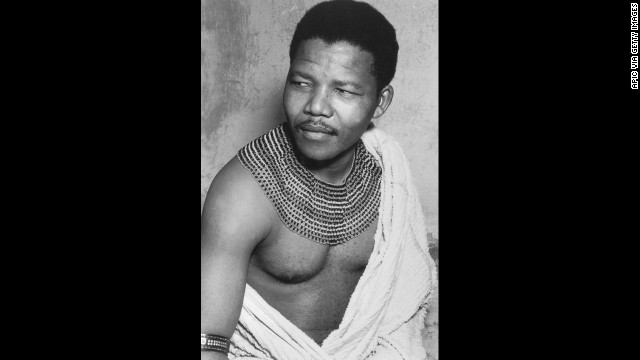 Mandela poses for a photo, circa 1950.
Mandela poses for a photo, circa 1950.  Mandela poses in boxing gloves in 1952.
Mandela poses in boxing gloves in 1952. 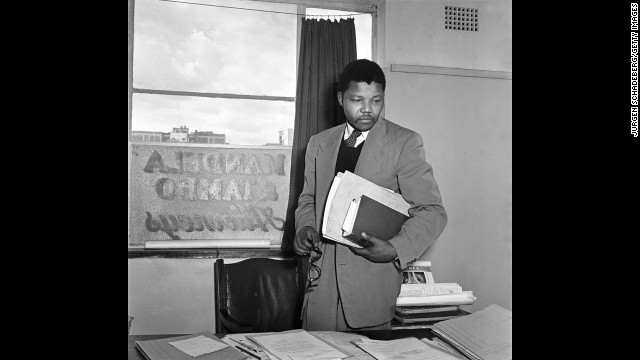 Mandela in the office of Mandela & Tambo, a law practice set up in Johannesburg by Mandela and Oliver Tambo to provide free or affordable legal representation to black South Africans.
Mandela in the office of Mandela & Tambo, a law practice set up in Johannesburg by Mandela and Oliver Tambo to provide free or affordable legal representation to black South Africans.  From left: Patrick Molaoa, Robert Resha and Mandela walk to the courtroom for their treason trial in Johannesburg.
From left: Patrick Molaoa, Robert Resha and Mandela walk to the courtroom for their treason trial in Johannesburg.  Mandela married his second wife, social worker Winnie Madikizela, in 1958. At the time, he was an active member of the African National Congress and had begun his lifelong commitment to ending segregation in South Africa.
Mandela married his second wife, social worker Winnie Madikizela, in 1958. At the time, he was an active member of the African National Congress and had begun his lifelong commitment to ending segregation in South Africa. 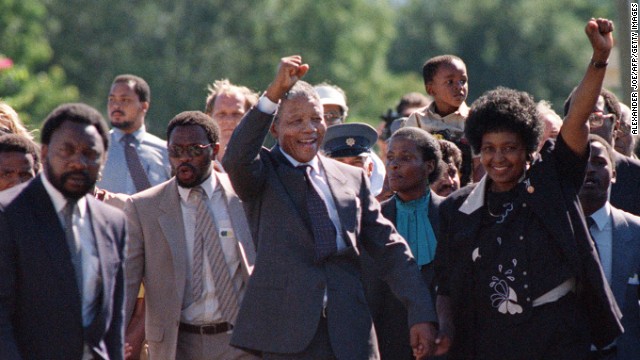 Nelson and Winnie Mandela raise their fists to salute a cheering crowd upon his 1990 release from Victor Verster Prison. He was still as upright and proud, he would say, as the day he walked into prison 27 years before.
Nelson and Winnie Mandela raise their fists to salute a cheering crowd upon his 1990 release from Victor Verster Prison. He was still as upright and proud, he would say, as the day he walked into prison 27 years before. 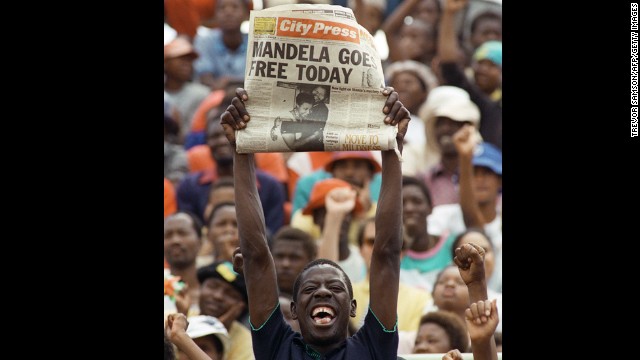 A jubilant South African holds up a newspaper announcing Mandela's release from prison at an ANC rally in Soweto on February 11, 1990. Two days later, more than 100,000 people attended a rally celebrating his release from jail.
A jubilant South African holds up a newspaper announcing Mandela's release from prison at an ANC rally in Soweto on February 11, 1990. Two days later, more than 100,000 people attended a rally celebrating his release from jail.  Mandela and Zambian President Kenneth Kaunda arrive at an ANC rally on March 3, 1990, in Lusaka, Zambia. Mandela was elected president of the ANC the next year.
Mandela and Zambian President Kenneth Kaunda arrive at an ANC rally on March 3, 1990, in Lusaka, Zambia. Mandela was elected president of the ANC the next year. 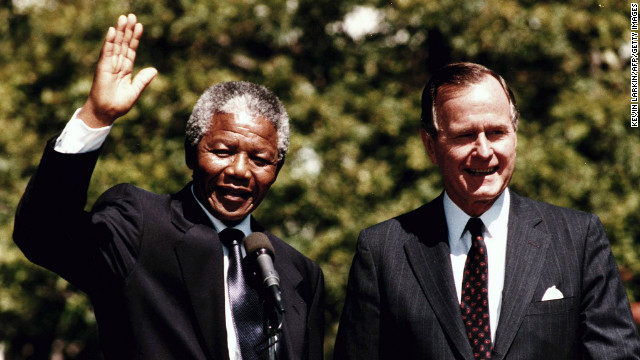 After his release in 1990, Mandela embarked on a world tour, meeting U.S. President George H.W. Bush at the White House in June.
After his release in 1990, Mandela embarked on a world tour, meeting U.S. President George H.W. Bush at the White House in June. 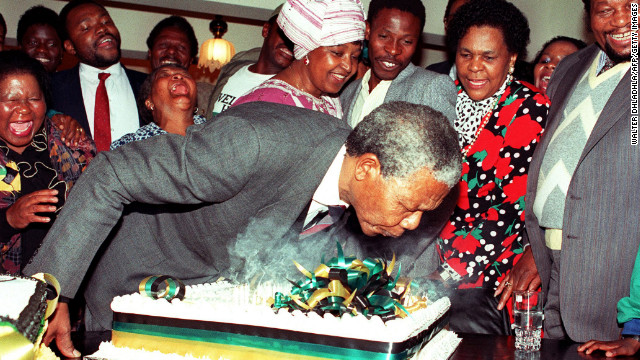 At his Soweto home on July 18, 1990, Mandela blows out the candles on his 72nd birthday cake. It was the first birthday he celebrated as a free man since the 1960s.
At his Soweto home on July 18, 1990, Mandela blows out the candles on his 72nd birthday cake. It was the first birthday he celebrated as a free man since the 1960s. 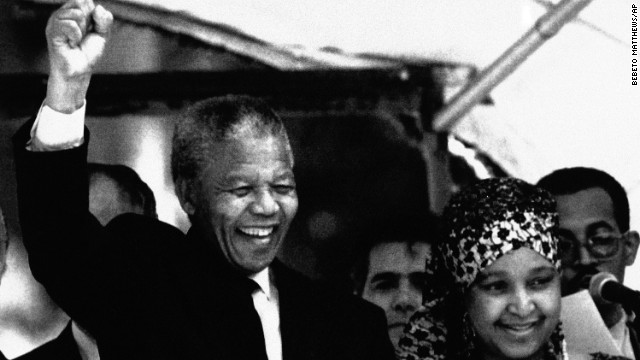 Mandela and his wife react to supporters during a visit to Brazil at the governor's palace in Rio De Janeiro, on August 1, 1991.
Mandela and his wife react to supporters during a visit to Brazil at the governor's palace in Rio De Janeiro, on August 1, 1991.  South African President Frederik de Klerk, right, and Mandela shared a Nobel Peace Prize in 1993 for their work to secure a peaceful transition from apartheid rule.
South African President Frederik de Klerk, right, and Mandela shared a Nobel Peace Prize in 1993 for their work to secure a peaceful transition from apartheid rule. 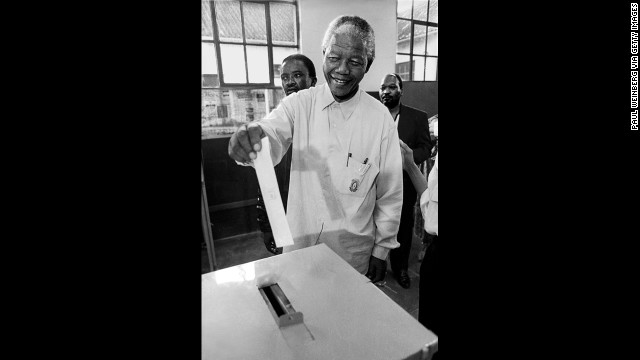 Mandela votes for the first time in his life on March 26, 1994.
Mandela votes for the first time in his life on March 26, 1994. 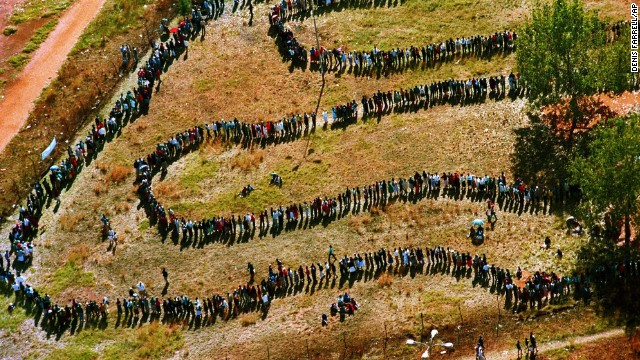 On April 27, 1994, a long line of people snake toward a polling station in the black township of Soweto outside of Johannesburg in the nation's first all-race elections.
On April 27, 1994, a long line of people snake toward a polling station in the black township of Soweto outside of Johannesburg in the nation's first all-race elections. 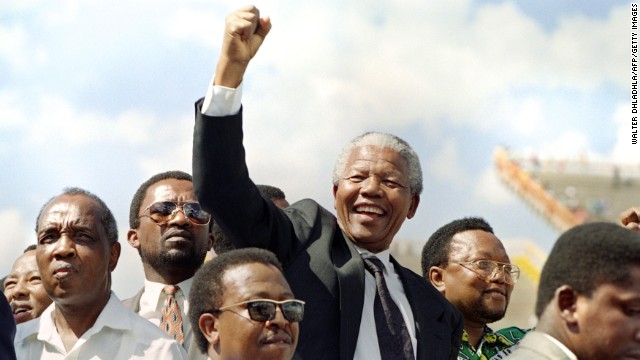 Mandela in Mmabatho for an election rally on March 15, 1994.
Mandela in Mmabatho for an election rally on March 15, 1994. 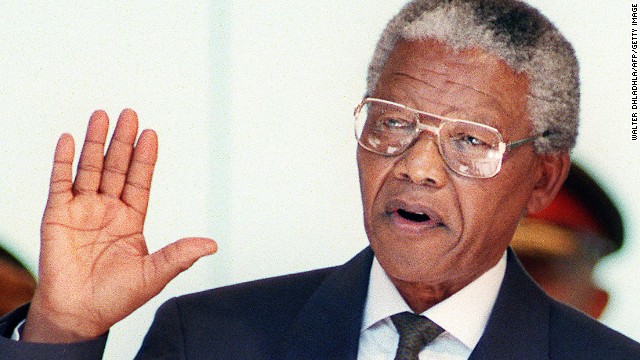 Mandela was elected president in the first open election in South African history on April 29, 1994. He's pictured here taking the oath at his inauguration in May, becoming the nation's first black president.
Mandela was elected president in the first open election in South African history on April 29, 1994. He's pictured here taking the oath at his inauguration in May, becoming the nation's first black president.  Mandela, left, cheers as Springbok Rugby captain Francois Pienaar holds the Webb Ellis trophy high after winning the World Cup Rugby Championship in Johannesburg on June 24, 1995.
Mandela, left, cheers as Springbok Rugby captain Francois Pienaar holds the Webb Ellis trophy high after winning the World Cup Rugby Championship in Johannesburg on June 24, 1995. 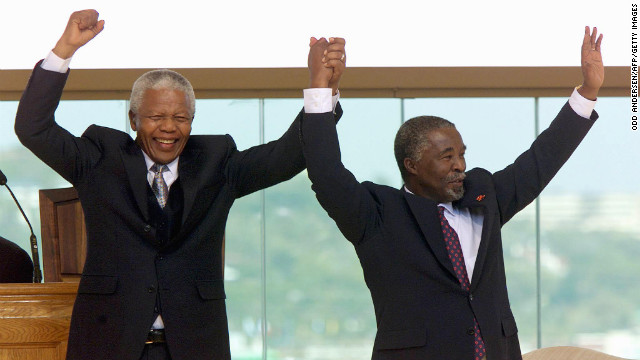 After one term as president, Mandela stepped down. Thabo Mvuyelwa Mbeki, at right, was sworn in as his replacement in June 1999.
After one term as president, Mandela stepped down. Thabo Mvuyelwa Mbeki, at right, was sworn in as his replacement in June 1999.  Mandela sits outside his former prison cell on Robben Island on November 28, 2003, ahead of his AIDS benefit concert at Green Point Stadium in Cape Town. He was sent to the infamous prison five miles off the coast of South Africa, where he spent 18 of his 27 years behind bars.
Mandela sits outside his former prison cell on Robben Island on November 28, 2003, ahead of his AIDS benefit concert at Green Point Stadium in Cape Town. He was sent to the infamous prison five miles off the coast of South Africa, where he spent 18 of his 27 years behind bars. 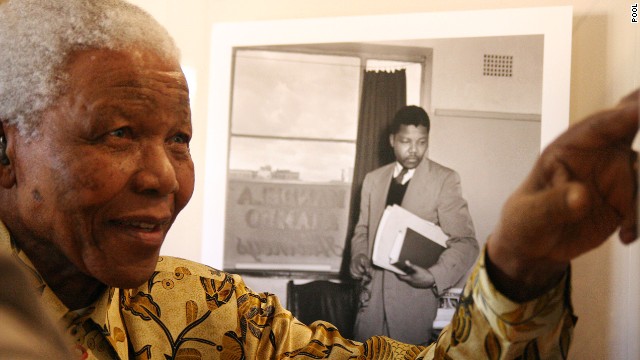 Mandela shows something to a group of international journalists visiting the Nelson Mandela Foundation in Johannesburg in May 2004.
Mandela shows something to a group of international journalists visiting the Nelson Mandela Foundation in Johannesburg in May 2004. 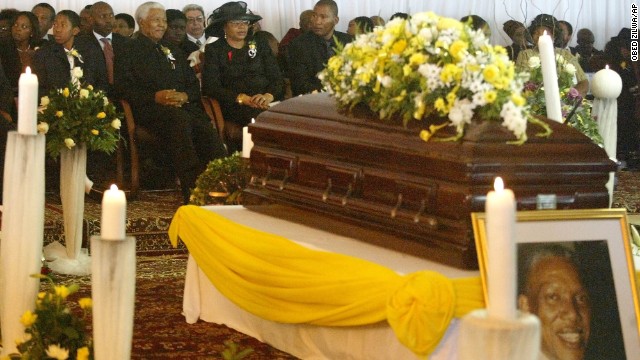 Mandela sits with his wife, Graca Machel, and his grandchildren at his son's funeral on January 15, 2005. He disclosed that his son, Makgatho Lewanika Mandela, had died of AIDS and said the disease should be given publicity so people would stop viewing it as extraordinary.
Mandela sits with his wife, Graca Machel, and his grandchildren at his son's funeral on January 15, 2005. He disclosed that his son, Makgatho Lewanika Mandela, had died of AIDS and said the disease should be given publicity so people would stop viewing it as extraordinary. 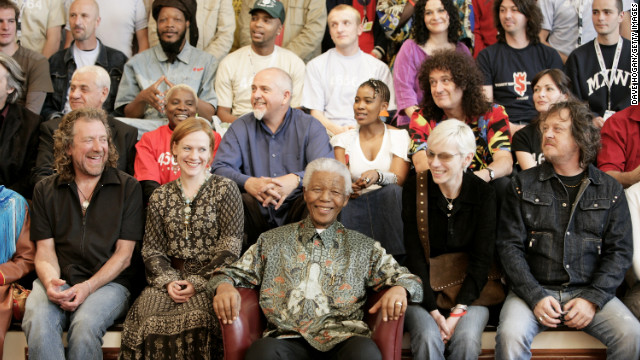 The "46664 Arctic" benefit concert was held in Tromso, Norway, on June 11, 2005. 46664 was Mandela's identification number in prison. Here, artists who performed at the event surround him.
The "46664 Arctic" benefit concert was held in Tromso, Norway, on June 11, 2005. 46664 was Mandela's identification number in prison. Here, artists who performed at the event surround him. 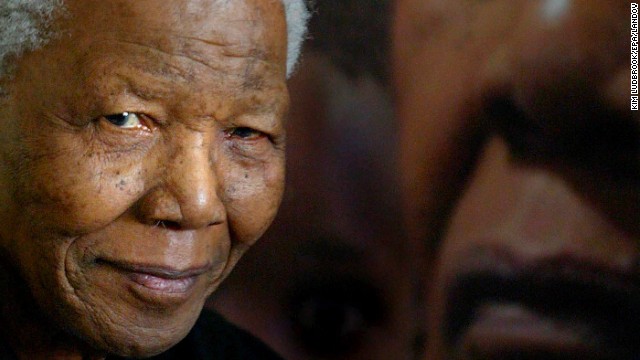 Mandela attends an HIV/AIDs concert in Johannesburg on February 17, 2005.
Mandela attends an HIV/AIDs concert in Johannesburg on February 17, 2005.  Former U.S. President Bill Clinton leans down to whisper to former South African President Nelson Mandela during a visit to the Nelson Mandela Foundation on July 19, 2007, in Johannesburg.
Former U.S. President Bill Clinton leans down to whisper to former South African President Nelson Mandela during a visit to the Nelson Mandela Foundation on July 19, 2007, in Johannesburg.  A bronze statue of Mandela was unveiled in Parliament Square in London on August 29, 2007. The 9-foot statue faces the Houses of Parliament.
A bronze statue of Mandela was unveiled in Parliament Square in London on August 29, 2007. The 9-foot statue faces the Houses of Parliament. 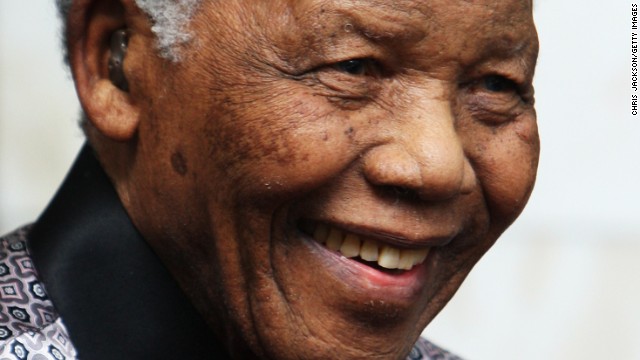 Mandela leaves the InterContinental Hotel after a photoshoot with celebrity photographer Terry O'Neil on June 26, 2008, in London.
Mandela leaves the InterContinental Hotel after a photoshoot with celebrity photographer Terry O'Neil on June 26, 2008, in London. 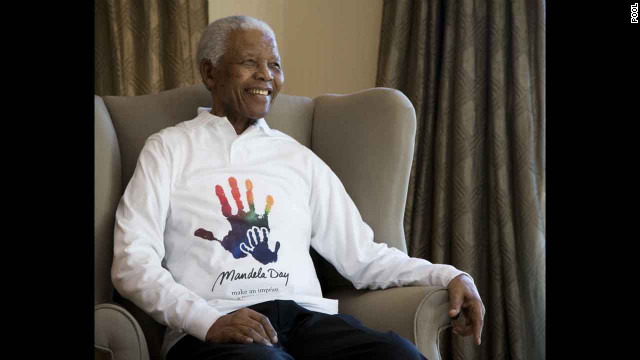 Mandela meets in 2009 with international children as part of his 46664 Foundation.
Mandela meets in 2009 with international children as part of his 46664 Foundation.  Nelson Mandela and his third wife, Graca Machel, arrive at the 2010 World Cup before the final match between Netherlands and Spain on July 11, 2010, at Soccer City Stadium in Soweto.
Nelson Mandela and his third wife, Graca Machel, arrive at the 2010 World Cup before the final match between Netherlands and Spain on July 11, 2010, at Soccer City Stadium in Soweto. 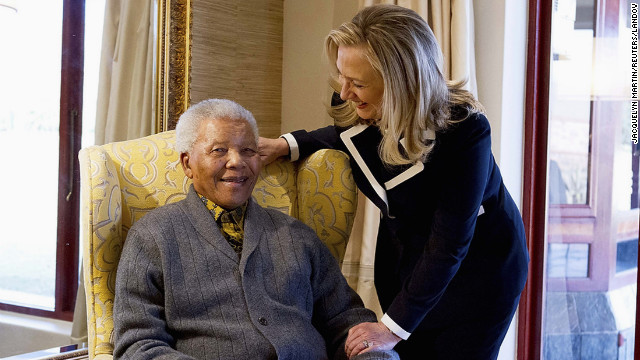 Then-U.S. Secretary of State Hillary Clinton meets with Mandela at his home in Qunu, South Africa, on August 6, 2012. The evolution of Nelson Mandela The evolution of Nelson Mandela The evolution of Nelson Mandela The evolution of Nelson Mandela The evolution of Nelson Mandela The evolution of Nelson Mandela The evolution of Nelson Mandela The evolution of Nelson Mandela The evolution of Nelson Mandela The evolution of Nelson Mandela The evolution of Nelson Mandela The evolution of Nelson Mandela The evolution of Nelson Mandela The evolution of Nelson Mandela The evolution of Nelson Mandela The evolution of Nelson Mandela The evolution of Nelson Mandela The evolution of Nelson Mandela The evolution of Nelson Mandela The evolution of Nelson Mandela The evolution of Nelson Mandela The evolution of Nelson Mandela The evolution of Nelson Mandela The evolution of Nelson Mandela The evolution of Nelson Mandela The evolution of Nelson Mandela The evolution of Nelson Mandela The evolution of Nelson Mandela The evolution of Nelson Mandela The evolution of Nelson Mandela The evolution of Nelson Mandela HIDE CAPTION << <
Then-U.S. Secretary of State Hillary Clinton meets with Mandela at his home in Qunu, South Africa, on August 6, 2012. The evolution of Nelson Mandela The evolution of Nelson Mandela The evolution of Nelson Mandela The evolution of Nelson Mandela The evolution of Nelson Mandela The evolution of Nelson Mandela The evolution of Nelson Mandela The evolution of Nelson Mandela The evolution of Nelson Mandela The evolution of Nelson Mandela The evolution of Nelson Mandela The evolution of Nelson Mandela The evolution of Nelson Mandela The evolution of Nelson Mandela The evolution of Nelson Mandela The evolution of Nelson Mandela The evolution of Nelson Mandela The evolution of Nelson Mandela The evolution of Nelson Mandela The evolution of Nelson Mandela The evolution of Nelson Mandela The evolution of Nelson Mandela The evolution of Nelson Mandela The evolution of Nelson Mandela The evolution of Nelson Mandela The evolution of Nelson Mandela The evolution of Nelson Mandela The evolution of Nelson Mandela The evolution of Nelson Mandela The evolution of Nelson Mandela The evolution of Nelson Mandela HIDE CAPTION << <
{ 0 comments... read them below or add one }
Post a Comment